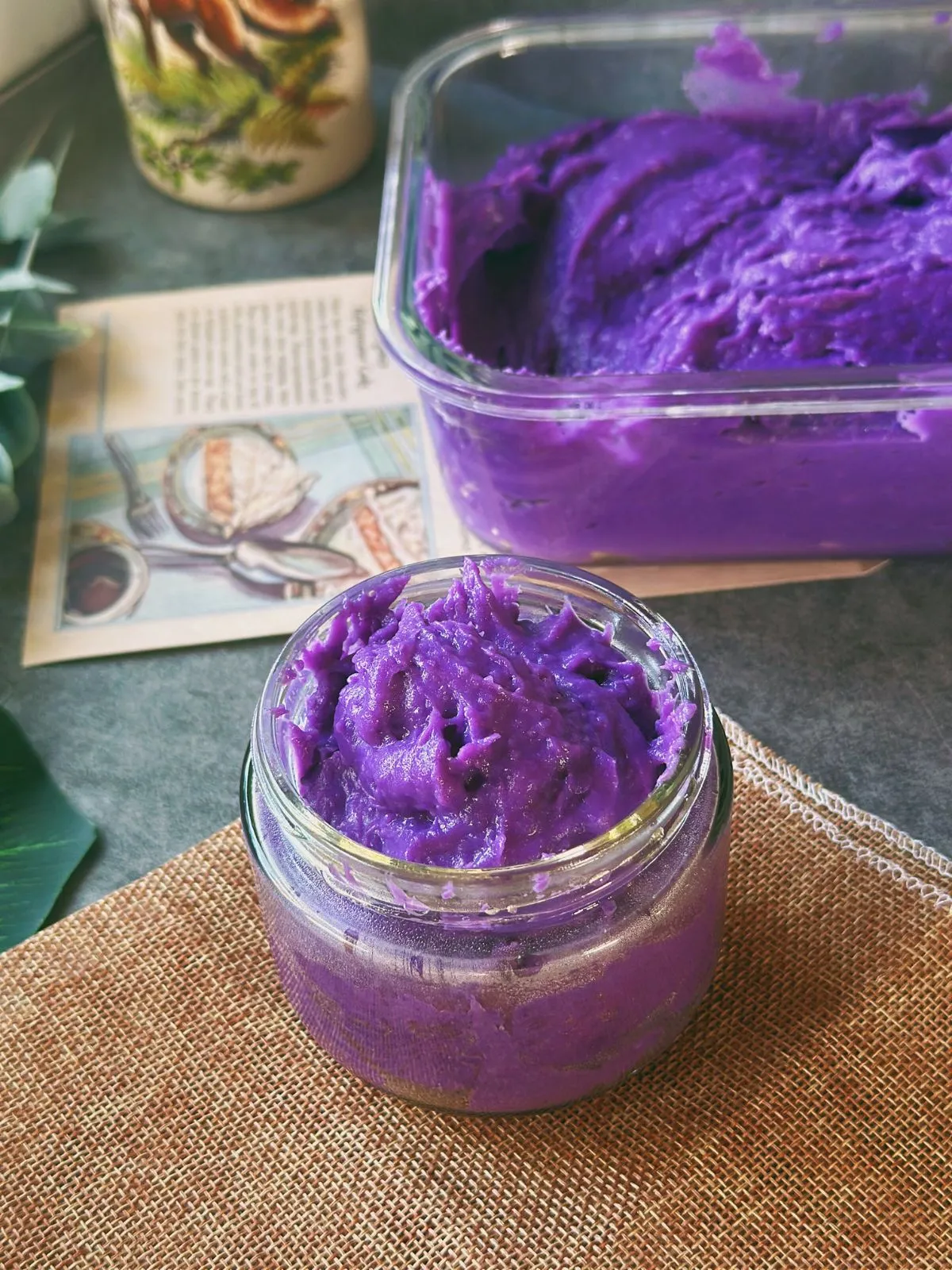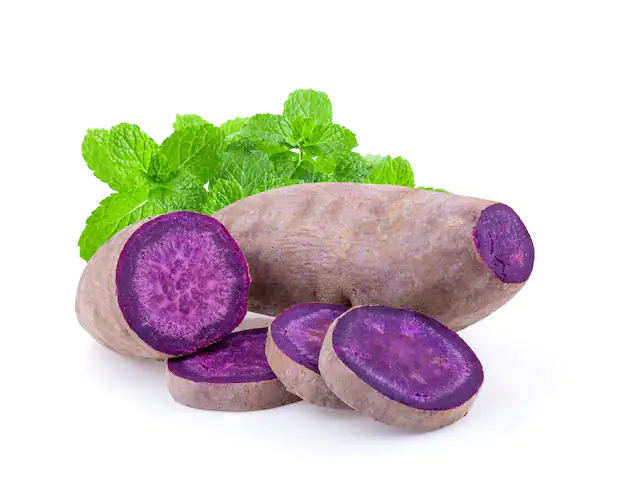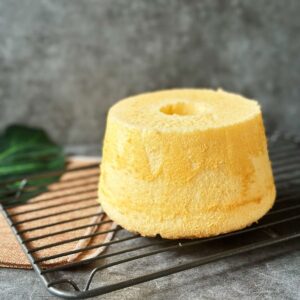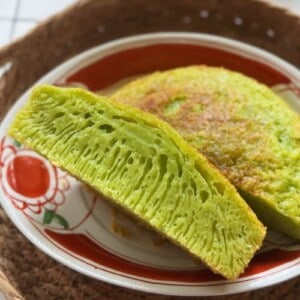Ube Halaya – a Filipino classic made from purple yams – delights with its velvety texture, nutty flavor, and gentle sweetness.
Surprisingly easy to make at home, it’s so good you’ll never want the store-bought version again!

What is Ube and Ube Halaya?
Ube (pronounced “oo-beh”) is a purple yam native to the Philippines, loved for its naturally vibrant color and subtly sweet, nutty, vanilla-like flavor.
Ube is a staple in Filipino desserts, showing up in everything from cakes and breads to ice cream.

On the blog, I’ve shared a few delicious ube recipes like Ube Chiffon Cake, Ube Honeycomb Cake, and Ube Leche Flan.
Ube Halaya (also called Halayang Ube) is a classic Filipino dessert made by cooking mashed ube with coconut milk, condensed milk, and butter until thick, smooth, and creamy.
Traditionally served as a chilled treat topped with butter or latik (toasted coconut curds), it’s also a base for many other Filipino sweets, like ube ice cream, hopia, or even halo-halo.

Today, alongside matcha, pandan, and Vietnamese coffee, ube has become a trending Asian dessert flavor.
It shines not only in traditional Filipino sweets but also in modern fusion creations like ube burnt cheesecake, ube crinkle cookies, ube Swiss roll, ube doughnuts, and even ube milk tea.
Personally, I adore ube halaya as a spread—slathered on soft shokupan or fragrant pandan bread, much like how I enjoy kaya, Southeast Asia’s beloved coconut jam.
Ube vs. Purple Sweet Potato vs. Taro
I’ve lost count of how many times I’ve seen food bloggers confuse ube with purple sweet potato. In the West, fresh ube is rare—usually frozen.
Here in Vietnam, fresh ube (Khoai Mỡ) is easy to find. Locals often make it into Canh Khoai Mỡ (savory purple yam soup) rather than desserts.
Ube is popular across Southeast Asia and sold in every local market. Back in Germany, when I bought frozen ube for soup, I sometimes found purple sweet potato mixed in—lol.
The good news? Even if you use purple sweet potato or taro for ube halaya, it’s still delicious.
Ube is a yam with rough, bark-like skin and uneven shapes. Cut it open, and you’ll find shades ranging from light lavender to a deep, bold purple. It’s naturally moist and creamy, which is why it makes dreamy desserts.

Purple sweet potato (khoai lang tím in Vietnamese, also called Okinawan sweet potato in Japan) has smoother skin and a long, tapered shape. Its flavor is sweeter, starchier, and drier than ube—closer to Japanese sweet potato.
It’s especially big in Japanese (satsumaimo) and Korean (goguma) cooking—you might have seen goguma lattes or even Korean sweet potato bread shaped like the real thing.

Taro (khoai môn in Vietnamese) is another one that often gets lumped in with ube, but it’s quite different. Its flavor is mild and nutty with just a hint of sweetness, and the flesh is usually white or off-white rather than purple.
Taro is hugely popular in both Vietnamese and Chinese cooking—you’ll find it in taro buns, taro ice cream, taro boba, and even taro pudding. I actually wrote a full post comparing ube vs. taro!

Ingredients

Fresh or Frozen Ube Yams: You can find them in most large Asian grocery stores. Fresh ube may be harder to come by, but frozen grated ube is widely available and makes a convenient substitute.
Ube Extract (optional): Deepens the purple hue and enhances the ube flavor. You can swap it with purple food coloring or simply leave it out.
Coconut Milk: Choose full-fat for the creamiest texture and richest taste.
Evaporated Milk: Brings a silky, creamy depth.
Sweetened Condensed Milk: Lends sweetness and richness. If available, try the ube-flavored version for an extra boost.
Brown Sugar (optional): Adjust to suit your preferred sweetness level.
Butter: Adds smoothness and a touch of luxury.
Salt: Just a pinch makes all the flavors pop.
Instructions
Making ube halaya is similar to preparing Anko (Japanese red bean paste) or mung bean paste for mooncakes. It’s a simple process that just requires a bit of patience.
- Step 1 – Prepare: If using fresh ube, peel the skin and cut it into small pieces. Boil it with a little water, or alternatively, steam or roast it wrapped in aluminum foil, until it’s soft and easily breakable. For frozen grated ube, be sure to defrost it first.
- Step 2 – Puree: Combine the ube with evaporated milk, coconut milk, and a pinch of salt. Puree the mixture until smooth and well-blended.
- Step 3 – Adjust: Transfer the mixture to a non-stick skillet, then add melted butter and sweetened condensed milk. Stir well and taste. If you prefer it sweeter, feel free to add more brown sugar.
- Step 4 – Cook: Cook the mixture over medium heat, stirring frequently and scraping the bottom of the skillet to prevent burning. Continue cooking for about 40-45 minutes, until the liquid evaporates and the mixture thickens. It’s ready when you can drag a spatula through it, and the line remains visible for a few seconds.





Storing
Room Temperature: If you’ll eat it the same day, it can sit out for up to 4–6 hours at a cool room temperature.
Refrigerator: Store in an airtight container for up to 5–7 days. It may firm up when chilled, so let it sit at room temp or warm it gently before serving.
Freezer: For longer storage, portion into airtight containers or freezer bags. It will keep for up to 2 months. Thaw overnight in the fridge and stir or reheat gently to restore its creamy texture.
Variations & Ideas
Cheese Topping: Add grated cheddar or a slice of cheese on top—Filipino-style! The salty-sweet combo is irresistible.
Ube Desserts: Use as filling for ensaymada (Filipino brioche), ube pie, ube buns or even mochi.
Spread: Slather on toast or pandesal like a jam.
Parfait or Halo-Halo: Layer with tropical fruits, jelly, or shaved ice for a refreshing treat.
With Ice Cream: Pair ube halaya with a scoop of coconut ice cream, pandan ice cream or ube ice cream for double the indulgence.
More Asian bakery delights

(Vietnamese Steamed Banana Cake)

Ube Halaya (Filipino Purple Yam Jam)
Equipment
- 1 Food Processor
- 1 nonstick skillet
Ingredients
- 1.1 lb ube yam (peeled) or frozen grated ube (~500g, more or less)
- 1 cup coconut milk (full-fat) (~250ml)
- 1 cup evaporated milk (~250ml)
- 1 can sweetened condensed milk
- Brown sugar (optional, to taste)
- 2 tbsp melted butter (30g)
- ½ tsp ube extract
- ½ tsp salt
Instructions
- Peel and cut the ube yam into small chunks. Add enough water to a pot to cover about one-third to one-half of the ube and boil until soft and mashable. Or you could steam the ube or roast it in the oven wrapped in aluminum foil.If using frozen grated ube yam, defrost it before proceeding.
- Combine the cooked or defrosted ube with evaporated milk, coconut milk, and salt. Blend the mixture until smooth and creamy.
- Pour the mixture into a non-stick pan. Add the melted butter and sweetened condensed milk. Stir well, tasting and adjusting the sweetness – if you like it sweeter, you can add extra brown sugar.
- Heat over medium heat, stirring frequently and scraping the bottom of the pan to prevent burning. Cook for 40–45 minutes, or until the liquid has evaporated and the mixture reaches a thick, creamy consistency. It’s ready when a spatula dragged through the mixture leaves a visible trace for a few seconds.
- Allow the ube halaya to cool completely before transferring it to an airtight jar. Store in the refrigerator for up to a week. For longer storage, divide it into smaller portions and freeze for up to 3 months.



